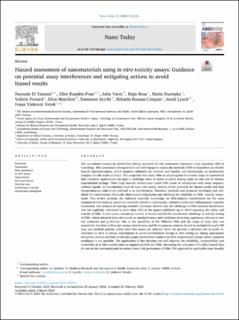| dc.contributor.author | El Yamani, Naouale | |
| dc.contributor.author | Rundén-Pran, Elise | |
| dc.contributor.author | Varet, Julia | |
| dc.contributor.author | Beus, Maja | |
| dc.contributor.author | Dusinska, Maria | |
| dc.contributor.author | Fessard, Valerie | |
| dc.contributor.author | Moschini, Elisa | |
| dc.contributor.author | Serchi, Tommaso | |
| dc.contributor.author | Cimpan, Mihaela-Roxana | |
| dc.contributor.author | Lynch, Iseult | |
| dc.contributor.author | Vinković Vrček, ivana | |
| dc.date.accessioned | 2024-04-05T12:48:05Z | |
| dc.date.available | 2024-04-05T12:48:05Z | |
| dc.date.created | 2024-03-07T18:37:29Z | |
| dc.date.issued | 2024 | |
| dc.identifier.issn | 1748-0132 | |
| dc.identifier.uri | https://hdl.handle.net/11250/3125114 | |
| dc.description.abstract | The movement towards an animal-free testing approach for risk assessment represents a key paradigm shift in toxicology. Risk assessment of engineered and anthropogenic nanoscale materials (NM) is dependent on reliable hazard characterization, which requires validated test methods and models, and increasingly on mechanistic insights into the mode of action. The properties that make NMs so advantageous for a wide range of commercial and industrial applications also pose a challenge when it comes to safety testing under in vitro and in chemico experimental settings. Their large reactive surface area makes NMs prone to interactions with assay reagents, readout signals, or intermediate steps of many test assays, leading to the potential for biased results and data inconsistencies, collectively referred to as interferences. Therefore, methods and protocols developed and validated for conventional chemicals often require adaptation and checking for reliability in NMs' toxicity assessment. This review presents the collected scientific knowledge on NMs-induced interferences for the most common in vitro toxicity assays and methods related to cytotoxicity, oxidative stress and inflammatory response evaluation. Our analysis of existing scientific literature showed that the challenge of NMs-induced interference was not explicitly addressed in more than 90% of the papers published up to 2014 reporting the safety and toxicity of NMs. In later years, increasing number of studies tackled the interference challenge in toxicity testing of NMs, which initiated exhaustive work on standardization and validation of existing regulatory-relevant in vitro test protocols and guidelines. Due to the specificity of the different NMs and the range of ways they can potentially interfere with in vitro assays, interference and fit-for purpose controls should be included for each NM type and method applied, unless label-free assays are selected. Here, we provide a decision tree to guide researchers on how to design experiments to avoid interferences during in vitro testing by taking appropriate mitigation actions and how to include proper interference controls in their experimental design where complete avoidance is not possible. The application of this decision tree will improve the reliability, comparability and reusability of in vitro toxicity data on engineered NMs or ENMs, increasing the relevance of in silico hazard data for use in risk assessment and in science-based risk governance of NMs. The approach is applicable more broadly also, to advanced materials and to hazard assessment of anthropogenic nanoscale materials such as microplastic and tyre-wear particles. | en_US |
| dc.language.iso | eng | en_US |
| dc.rights | Navngivelse 4.0 Internasjonal | * |
| dc.rights.uri | http://creativecommons.org/licenses/by/4.0/deed.no | * |
| dc.title | Hazard assessment of nanomaterials using in vitro toxicity assays: Guidance on potential assay interferences and mitigating actions to avoid biased results | en_US |
| dc.title.alternative | Hazard assessment of nanomaterials using in vitro toxicity assays: Guidance on potential assay interferences and mitigating actions to avoid biased results | en_US |
| dc.type | Peer reviewed | en_US |
| dc.type | Journal article | en_US |
| dc.description.version | publishedVersion | en_US |
| dc.rights.holder | © 2024 The Author(s). Published by Elsevier Ltd. | en_US |
| dc.source.volume | 55 | en_US |
| dc.source.journal | Nano Today | en_US |
| dc.identifier.doi | 10.1016/j.nantod.2024.102215 | |
| dc.identifier.cristin | 2252928 | |
| dc.relation.project | NILU: 119011 | en_US |
| dc.relation.project | NILU: 119012 | en_US |
| dc.relation.project | NILU: 121041 | en_US |
| dc.relation.project | NILU: 119044 | en_US |
| dc.relation.project | EC/H2020/8144259 | en_US |
| dc.relation.project | EC/H2020/814572 | en_US |
| dc.relation.project | EC/H2020/101008099 | en_US |
| dc.relation.project | Norges forskningsråd: 288768 | en_US |
| dc.source.articlenumber | 102215 | en_US |
| cristin.ispublished | true | |
| cristin.fulltext | original | |
| cristin.qualitycode | 1 | |

